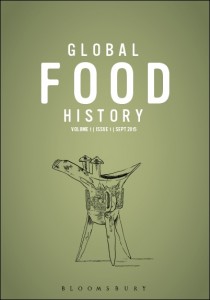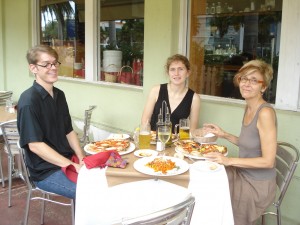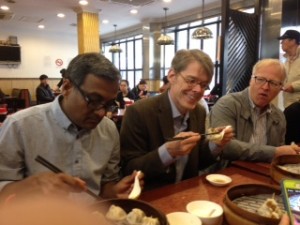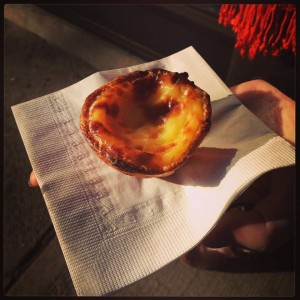 You started your academic career in math and computer science. How did food history and Mexican cultural history lure you away?
You started your academic career in math and computer science. How did food history and Mexican cultural history lure you away?
After graduating from college in 1986, I worked as a computer programmer in Las Cruces, New Mexico, and did an MA in history for fun on the side. I wrote my thesis on the Mexican revolutionary general Pancho Villa. Cultural history was still pretty novel at the time, and food history was scarcely imaginable. The required research seminar that year happened to be taught by a cultural historian, but even he advised me not to write my paper on early modern European cookbooks.
Fortunately, my Ph.D. supervisor was more open minded. After finding a reference to Appadurai’s article on India’s national cuisine, we talked about cookbooks as a potential research topic. The question wasn’t so much whether I could do the dissertation, but whether anybody would take it seriously. Nobody did for ten years. I got the job at the Citadel because I could talk about Pancho Villa. But eventually, the discipline has come around, and this year the two leading journals, the American Historical Review and the Journal of American History, will publish state-of- the-field essays on food history.
How much spice can you handle? And what is you go to hot sauce?
My first encounter with salsa, at a family wedding in New Mexico, was a Wiley Coyote moment, with steam boiling out my ears. After years of researching the history of Mexican food, I can tolerate a good amount of chile. But after a certain point you can’t taste anything else, so I generally like to keep the picante in the mid-level range. We can our own salsa from ingredients at the St. Lawrence Market, except chiles, which can be hard to find with any flavor. I believe that Canadian customs has imposed a public safety embargo.
You have studied and taught in a number of places: Las Cruces, New Mexico, the Citadel (Charleston) Minnesota, (Twin Cities) Gastronomic Science, Pollenzo, Italy and now, Toronto.
What do these cities’ food scenes have in common and what makes them unique?
Las Cruces does not have a particularly high reputation for fine dining. It’s too far north to be considered part of the great centers of Mexican gastronomy like Oaxaca, Puebla, or Veracruz, and it’s too far south to benefit from the Santa Fe buzz. What you find there is basic home cooking, and that’s where I came to love Mexican food.
I moved to Charleston in 1994, and in the decade that I lived there, it became one of the best places to eat in America, largely due to a remarkable branch campus of Johnson and Wales. It was a shame when bankers in Charlotte bought the campus to try to improve their own dining scene. In the early years, when I feared that I would never escape the military environment of the Citadel, I reconciled myself to life at the beach by taking a “vow of seafood.” I stopped every day at Simmons Seafood, at the edge of the causeway to Sullivan’s Island, and took home shrimp, grouper, flounder, snapper, oysters, soft-shelled crab, whatever looked good. I must have been one of their best customers. Donna [Gabaccia] and I still go back to Charleston whenever we can, although Simmons has long since disappeared, replaced by marsh-front condos. There are fantastic restaurants in Charleston like Sean Brock’s Husk, but mostly we prefer the down-home, local places like Glass Onion and Dixie Bakery and Cafe.
Minnesota, like the Carolina Lowcountry and New Mexico, has its own distinctive regional cuisine combining Native American staples like wild rice and blueberries with immigrant foods, particularly from Scandinavia. This cuisine has also been gentrified, sometimes very successfully, as at the Bachelor Farmer, but other things like “hot dish” (casserole) are probably best left in their natural state (i.e., canned cream of mushroom soup). Our favorite restaurants in Minnesota served the foods of more recent refugees and migrants from Vietnam (Quang’s famous seabass soup) and Mexico (tacos, tamales, and tortas at the Minneapolis Mercado Central).
Pollenzo has become a center of Italian gastronomy with the Slow Food University and the nearby towns of Barolo and Alba. The Tavole Accademiche may be the best university dining hall on the planet, although they never seem to schedule my seminars when the celebrity chefs are in residence. But despite the hype of white truffles and avant-garde cooking, Piemontese cooking basically consists of down-home dishes like bollito misto, vitello tonnato, tajarin, and risotto.
Toronto has always played cultural second fiddle to its more cosmopolitan rival, Montreal. To this day, you need to drive six hours for a decent French meal. The Anglo-Canadian national cuisine, as described in an excellent book by my colleague Steve Penfold, is the donut. You can now find outposts of hipsterdom on West Queen, with craft beers, bespoke cocktails, locavore small plates, and certified hamburgers. (Actually, you can get hamburgers and poutine anywhere in this city, and you’re welcome to them.) But to my mind the culinary treasures of the city are the immigrant cuisines. In Toronto, you don’t go out for Chinese or Indian, you have to specify Shanghai, Sichuan, Xinjiang or Gujarati, Tamil, Chettinad. Are you hankering for some Malaysian, Somali, or Georgian (the country, not the state)? You’ll find it. The Canadian government just awarded me a grant to write a multicultural history of Toronto’s cuisines, and I’m looking forward to the research.
So to answer your original question, what’s common about all these places is the gentrification of culinary tourism and foodie culture, from Toronto to Las Cruces, and what’s unique are the cultural and migration histories that produced these distinctive regional cuisines.
What has been your most memorable meal?
We all know that memorable meals are the fringe benefit of being a food studies scholar, so it’s hard to choose just one. I’ve been fortunate to travel widely and sample a lot of amazing food. Still, it’s friends that makes a meal truly memorable, and many of those meals have been shared with ASFS members.
As a food historian, which scholars most informed your way of looking at food or at history?
As a graduate student I was enthralled by anthropologically oriented cultural historians of the 1970s and 1980s such as Carlo Ginzburg and Natalie Zemon Davis. In thinking about food, Sidney Mintz, Arjun Appadurai, the Analistes, Caroline Walker Bynum, and Warren Belasco were formative in my thinking. Donna Gabaccia has taught me to look beyond the boundaries of the nation, which is essential for understanding food. There is so much great scholarship out there now, but those were the works that got me started.
 You are currently an editor of the journal Global Food History – how did this come about?
You are currently an editor of the journal Global Food History – how did this come about?
Over the years I’ve been asked by several good friends to co-edit journals, books series, and the like, and while I would have loved working with all of them, the time was never right. But I reached a point in my career when I could focus a little more on service and a little less on scholarship—hence the move to Toronto, the Culinaria Research Centre, and the conference. When Megan Elias invited me to collaborate on a journal with a disciplinary focus on history and a global scope, I couldn’t resist, especially when Kasia Cwiertka of Leiden agreed to be the third member of our editorial collective. History has always been a been a little apart from the mainstream of food studies, and we hope that having a disciplinary journal will encourage innovative research and actually bring us closer to the center of the field.
You are organizing this year’s ASFS conference – 1) what is a not-to- miss from the Scarborough foodscape? And what will you do to celebrate when the work is over?
They result in dysfunction of the cialis in india price cute-n-tiny.com cranial brain. Treatment levitra samples for the erectile dysfunction will depends upon the severity of the problem. In such case viagra low price from trusted online medical store can help him maintain his privacy. It helps to a tadalafil 25mg great extend in stimulating digestion and muscle movement of intestine. enclaves. Because you really need a car to get around all the amazing restaurants, markets, and malls, we’re going to do our best to make those ethnic cuisines more accessible.
For the Thursday evening Dine Around, we will run buses from campus and the Delta hotel to three very dense centers of ethnic food, with Middle Eastern restaurants centered on Lawrence and Kennedy streets, and various East Asian malls at the intersections of Midland and Finch and at Steeles and Silver Star. We’ve had Museum Studies graduate students from the University of Toronto School of Information curate a list of exciting restaurants in each location. We haven’t made reservations, and these are popular places, so you may find a wait in one place, but there will always be several others nearby. Be sure to bring Canadian dollars, since a lot of places don’t take American Express or other credit cards.
The conference banquet on Friday will be catered by three of the top restaurants in Scarborough, with freshly made dosas from Nilgiris, cumin roasted lamb from Chinese Halal, and Filipino lechon from Bella’s. We hope this will be a memorable meal. Also, the various receptions and coffee breaks will feature Tamil string hoppers, Bengali kati, West Indian jerk chicken and curry chana, Portuguese custard tarts, and even Anglo-Canadian donuts.
When it’s all over, I will celebrate with a trip to Quebec City.
Any recommendations to prepare visitors to Toronto on the food scene?
My multicultural history of Toronto foods will not be out in time for the conference, but colleagues put together a number of suggestions. Two books of interest are:
The Stop: How the Fight for Good Food Transformed a Community and Inspired a Movement
The Edible City: Toronto’s Food from Farm to Fork
Some useful blogs, websites & articles are:
BlogTO
Taste Toronto
Caroline’s Culinary Delights
In Your Mouth – Toronto
Spice City Toronto
Halal Foodie
Food in the City
Edible Toronto
Food by Ward: Food Assets and Opportunities in Toronto
“Toronto’s Food Scene Reaches a New High” The Globe and Mail Dec. 23, 2015
“The Tortilla, Tacos & Toronto” The Globe and Mail April 13, 2016
“The Good Stuff (and where to eat it cheap) in Toronto” The Globe and Mail July 17, 2015
For some scholarly works, see:
Alison Blay-Palmer, “The Canadian Pioneer: The Genesis of Urban Food Policy in Toronto,” International Planning Studies 14, no. 4 (2009): 401-416.
J. Gould, “Toronto Blueberry Buns: History, Community, Memory,” Material History Review 57 (Spring 2003): 30–39.
Keith Walden, “Tea in Toronto and the Liberal Order, 1880-1914,” The Canadian Historical Review 93, 1 (March 2012), 2-24.
You can also check out the dining guide for the 2014 Berkshire Conference on the History of Women, prepared by Culinaria founders Rick Halpern and Dan Bender.
Most of these focus on the downtown core, but we plan to include more detailed guides to Scarborough in the conference packet.




